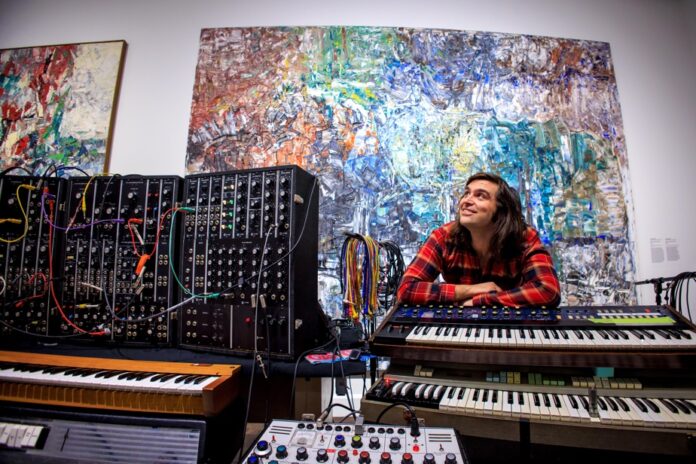Surrounded by around fifteen carefully selected works by Jean Paul Riopelle, the artist installed at the Claire and Marc Bourgie pavilion, for five consecutive days, a studio made up of an impressive number of Moog brand instruments. The structure included analog synthesizers, a transistor organ and an electromechanical piano. If most of the devices are an integral part of Mathieu David Gagnon’s personal collection, the Montreal Museum of Fine Arts (MMFA) was able to add to the lot a very rare piece kept at Laval University.
“These are machines that were invented in the same years as Riopelle’s creations,” explains the composer in reference to the series of lithographs, Leaves (1967), which hangs on the rails of his “studio”.
The discovery of this series, which went more silently in Riopelle’s production, was a revelation for Mathieu David Gagnon, who creates by accumulating layers of sounds, which is reminiscent of the technique of printmaking. .
Like the renowned painter, the musician is also driven by the element of openness and chance that creation involves and which, in his case, can be provided by analog synthesizers. “My life changed the day I bought an old Minimoog. When [the instruments] don’t quite do what they’re supposed to do, it results in things you wouldn’t have thought of. »
“That’s why there are so many instruments here: [these] inspire me a lot,” reveals the musician, who always analyzes a physical section of a particular synthesizer in depth before moving on to another. His approach also justifies the fact that no digital device is part of the creative space.
Accompanied by musician Antoine Létourneau-Berger, Mathieu David Gagnon performed for eight hours a day in his “studio” during this residency. “I wanted to recall the first minimalism concerts. [The musicians] played full nights. […] People came in, went out, slept. It was a deal in the 1960s.”
According to the artist, the idea for making electronic music at the museum came from the Moog synthesizer concert that took place at the Museum of Modern Art (MoMA) in 1969 as part of the Jazz in the Garden series.
Let us emphasize that if music has gradually carved out a place for itself in museum institutions since this New York event, the Montreal Museum of Fine Arts has been able to assert itself as one of the leaders in the field thanks to the exhibitions Warhol Live (2008) or, more recently, Full Volume: Basquiat and Music (2022).
According to the general director of the MMFA, Stéphane Aquin, “museums sanitize art history [when] there are just paintings. Art is often created in a pool of ideas, which flow from one form to another. It happens in the workshop, sometimes with music, in collaboration.” He points out that the MMFA “restores the texture to this art history,” which can make for a fascinating reading of the works.
In the case of the Flore Laurentienne project, however, it is a question of developing this relationship between music and museum even more in depth. “It’s a real creative residence,” continues Stéphane Aquin.
The idea of a residency germinated when Flore Laurentienne wrote the original music for the podcast Dépaître Riopelle, broadcast on the OHdio platform of Radio-Canada. “I surprised myself by being so inspired by Riopelle and by painting,” confides the composer.
The ties that unite the two artists are far from limited to a common interest in the landscapes surrounding the St. Lawrence River from the heights of Kamouraska. Flore Laurentienne transcends the commonplaces of a reading of Riopelle focused on nature and geese or even on abstraction and relationships to automatism. It’s a new look off the beaten track that is being taken. The project creates a connection between electronic music and the visual arts of the 1950s and 1960s and questions the spirit of the era in a different way.
Is this music residency the start of a new series at the MMFA? It seems that the project is rather unique in the eyes of its general director, who wants to wait until another strong proposal presents itself. “It’s the artists who lead us,” he concludes.















